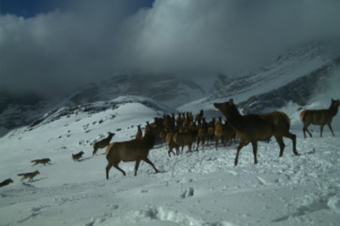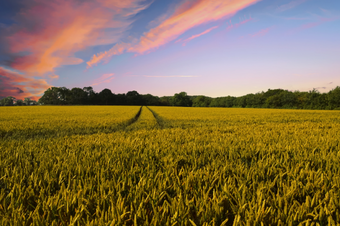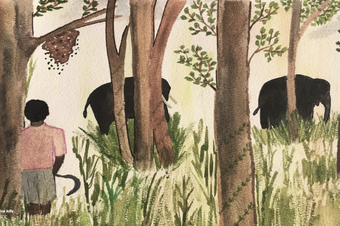
How useful is genomic data for predicting maladaptation to future climate?
“Methods using genomic information to forecast population maladaptation to climate change are becoming increasingly common, yet the lack of model validation poses serious hurdles toward their incorporation into management and policy. Here, we compare the validation of two methods – Gradient Forests (GF) and the Risk Of Non-Adaptedness – using exome capture pool-seq data from 35 to 39 populations across three conifer taxa: two Douglas-fir varieties and jack pine. We evaluate sensitivity of these algorithms to the number of input populations as well as the source and number of input loci (markers selected from genotype-environment associations [GEA] or those selected at random). We validate these methods against two-year and 52-year growth and mortality measured in independent transplant experiments. “
Read more in the article by IBioS faculty member Dr. Sally Aitken and colleagues.

Local knowledge and practices among Tonga people in Zambia and Zimbabwe: A review
“There is increasing recognition of the role of Indigenous and local knowledge systems in sustainable land use and conservation practices. However, the evidence base remains fragmented, while local knowledge remains marginalised in many national biodiversity strategies and development plans. This applies to the Tonga people of Zambia and Zimbabwe. Here, we synthesise existing evidence of Tonga knowledge and practices to explore their potential contribution to the implementation of integrated landscape approaches that aim to incorporate multiple stakeholders’ objectives in landscape-scale management.”
Read more in the article by IBioS faculty member Dr. Terry Sunderland and colleagues.

Empirical examples demonstrate how relational thinking might enrich science and practice
“Interdependent relationships among humans and nature often go overlooked, delaying better environmental, social and public health outcomes. Emerging approaches have emphasized thinking through relationships, which we call ‘relational thinking’. Threads of relational thinking have matured in areas such as anthropology and Indigenous scholarship, and interest is growing across many disciplines. Welcoming this new cadre of relational thinkers requires a more broadly accessible synthesis. Sustainability scholars have begun to overcome these barriers with high-level overviews and broad calls to adopt relational thinking. This literature has investigated the conceptual underpinnings of relational thinking, but the concrete, empirical benefits of relational thinking for understanding human–natural systems remain obscure. Here, we introduce a wide range of accessible empirical examples to demonstrate the potential for relational thinking to illuminate diverse coupled human-and-natural systems. We complement these examples with an overview of the theory behind relational thinking.”
Read more in the article by IBioS faculty members Dr. Kai Chan, Dr. Terre Satterfield and colleagues.

Testing umbrella species and food-web properties of large carnivores in the Rocky Mountains
“Despite criticisms, the umbrella species concept remains a fundamental conservation tool for protecting biodiversity in the face of global change, yet it is rarely tested. Food web theory provides a tool to test both umbrella-species’ suitability and their ecological function, which we investigate in a large-mammal food web. Using data from 698 camera trap locations in the Canadian Rockies, we develop hierarchical occupancy models to predict the co-occurrence of 16 large mammal species. We draw upon previous diet studies in the Canadian Rockies to describe the meta food-web (meta-web) for these species. “
Read more in the article by IBioS faculty member Dr. Cole Burton and colleagues.

GEDI waveform metrics in vegetation mapping—a case study from a heterogeneous tropical forest landscape
“The distribution of different vegetation types is important information for landscape management, especially in the context of tackling global environmental change. Vegetation types can be mapped using satellite and airborne passive remote sensing. However, spectrally similar yet structurally different vegetation types, like different tree-dominated land covers, are often challenging to map using spectral information alone. We examined the potential of vertical vegetation structure acquired in the global ecosystem dynamics investigation (GEDI) mission that harnesses a space-borne waveform lidar sensor in vegetation mapping across a heterogeneous tropical landscape in Cambodia. “
Read more in the article by IBioS faculty member Dr. Naomi Schwartz and colleagues.

The diversity of organic farmer motivations and livelihoods in the Global South – A case study in Kerala, India
“Organic agriculture is often promoted as a means to achieve sustainable agriculture and livelihoods. Yet, the evidence is mixed on the outcomes of organic adoption. We conducted a case study in the South Indian state of Kerala to understand farmer motivations to adopt organic agriculture, their livelihood characteristics, and outcomes of adoption. “
Read more in the article by IBioS faculty member Dr. Navin Ramankutty and colleagues.

Semi-natural habitats on organic strawberry farms and in surrounding landscapes promote bird biodiversity and pest control potential
“Agricultural intensification and expansion have degraded biodiversity in agroecosystems, jeopardizing the ecosystem services provided by wildlife. Birds can act as particularly important purveyors of ecosystem services to farmers by consuming arthropod pests. Some bird species, however, may sometimes act as pests themselves by consuming crops. Further, on-farm management practices (e.g., crop diversity, vegetative structure) and the complexity of the surrounding landscape can shift the balance of bird-mediated ecosystem services and disservices through changes in bird community composition. “
Read more in the article by IBioS faculty member Dr. Claire Kremen and colleagues.

The contribution of Indigenous stewardship to an historical mixed-severity fire regime in British Columbia, Canada
“Indigenous land stewardship and mixed-severity fire regimes both promote landscape heterogeneity, and the relationship between them is an emerging area of research. In our study, we reconstructed the historical fire regime of Ne Sextsine, a 5900-ha dry, Douglas fir–dominated forest in the traditional territory of the T’exelc (Williams Lake First Nation) in British Columbia, Canada. Between 1550 and 1982 CE, we found median fire intervals of 18 years at the plot level and 4 years at the study-site level. Ne Sextsine was characterized by an historical mixed-severity fire regime, dominated by frequent, low-severity fires as indicated by fire scars, with infrequent, mixed-severity fires indicated by cohorts.”
Read more in the article by IBioS faculty member Dr. Shannon Hagerman and colleagues.

The influence of human activity on predator-prey spatiotemporal overlap
“Despite growing evidence of widespread impacts of humans on animal behavior, our understanding of how humans reshape species interactions remains limited. Here, we present a framework that draws on key concepts from behavioral and community ecology to outline four primary pathways by which humans can alter predator-prey spatiotemporal overlap. We suggest that predator-prey dyads can exhibit similar or opposite responses to human activity with distinct outcomes for predator diet, predation rates, population demography, and trophic cascades.”
Read more in the article by IBioS faculty member Dr. Kaitlyn Gaynor and colleagues.

Evidence of spatial competition, over resource scarcity, as a primary driver
of conflicts between small-scale and industrial fishers
“Accounts of fishing conflicts have been rising globally, particularly between small-scale and industrial vessels. These conflicts involve verbal or physical altercations, and may include destruction of boats, assault, kidnapping, and murder. Current scholarship around industrial/small-scale fishing conflicts theorizes them as a form of resource conflict, where fish scarcity is the dominant contributor to conflict and competition. Alternatively, conflicts may be driven by spatial competition, concentrating where there are increased encounters, unrelated to resource status.”
Read more in the article by IBioS faculty members Dr. Kaitlyn Gaynor and Dr. Rashid Sumaila

Priorities for synthesis research in ecology and environmental science
“Synthesis research in ecology and environmental science improves understanding, advances theory, identifies research priorities, and supports management strategies by linking data, ideas, and tools. Accelerating environmental challenges increases the need to focus synthesis science on the most pressing questions. To leverage input from the broader research community, we convened a virtual workshop with participants from many countries and disciplines to examine how and where synthesis can address key questions and themes in ecology and environmental science in the coming decade.”
Read more in the article by IBioS faculty member Dr. Kaitlyn Gaynor and colleagues.

Understanding the distribution and fine-scale habitat selection of mesocarnivores along a habitat quality gradient in western Himalaya
“Human activities have resulted in a rapid increase of modified habitats in proximity to wildlife habitats in the Himalaya. However, it is crucial to understand the extent to which human habitat modification affects wildlife. Mesocarnivores generally possess broader niches than large carnivores and adapt quickly to human activities. Here, we use a case study in the western Himalaya to test the hypothesis that human disturbance influenced mesocarnivore habitat use.”
Read more in the article by IBioS Faculty Dr. Cole Burton and colleague Ramesh Krishnamurthy.

New tree-level temperature response curves document sensitivity of tree growth to high temperatures across a US-wide climatic gradient
“Temperature is a key climate indicator, whose distribution is expected to shift right in a warming world. However, the high-temperature tolerance of trees is less widely understood than their drought tolerance, especially when it comes to sub-lethal impacts of temperature on tree growth. I use a large data set of annual tree ring widths, combined with a flexible degree day model, to estimate the relationship between temperature and tree radial growth.”
Read more in the article New tree-level temperature response curves document sensitivity of tree growth to high temperatures across a US-wide climatic gradient by IBioS faculty Assistant Professor Joséphine Gantois.

Indigenous insights on human–wildlife coexistence in southern India
“We examined Indigenous perspectives on human–wildlife coexistence in India by drawing ethnographic evidence from Kattunayakans, a forest-dwelling Adivasi community living in the Wayanad Wildlife Sanctuary in Kerala. Through qualitative field study that involved interviews and transect walks inside the forests, we found that Kattunayakans displayed tolerance and acceptance of wild animals characterized as forms of deep coexistence.”
Read more in the article by IBioS Research Associate and Program Manager Dr. Helina Jolly, IBioS Faculty Professor Terre Satterfield and colleagues.

Biodiversity targets will not be met without debt and tax justice
“Approaches to financing biodiversity conservation tend to focus on funding gaps but fail to address underlying political and economic drivers. We propose two strategies — tax reform and debt justice — to supercharge public financing for biodiversity and deflate harmful financial flows, while chipping away at the causes of state austerity.”
Read more in the article by IBioS faculty Professor Jessica Dempsey and colleagues.